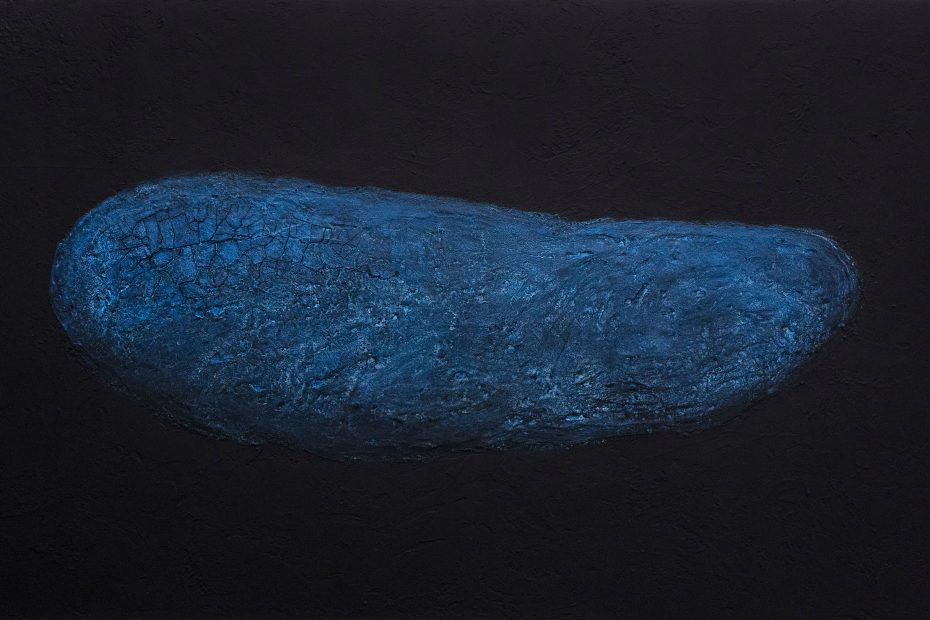CICA Museum M Gallery
May 1 – 5, 2024
2024.05.01 – 05
본인이 표현하고 있는 대지는 거칠고 험난한 마른 땅, 고단한 개척의 대상 또는 물살과 바람에 휘둘리고 부딪혀 깎여버린 몸이면서 한편으로는 씨앗을 뿌린 젖은 땅, 지금은 그 속에서 무엇을 틔워낼지 모르지만, 곧 발아하게 될 씨앗이 들어있는 잠재된 가능성의 상징이다. 그것은 스스로 생명을 가진 유기적 자생체로서 존재하고, 단단하고 굳은 의지로 거듭된 실패 속에서도 새로운 물질로의 재생과 변환을 꿈꾸는 연금술적 존재이다. 땅은 갈아엎을수록 비옥해지고 건강해진다. 인간이 자연에 변화를 가한다고 생각하지만, 장기적으로 볼 때 인간 존재의 시간은 유한적이며 오히려 자연의 시간은 영속적이다. 자연은 스스로 자신을 돌볼 줄 아는 내성(內城)을 가졌다. 이런 자가조절(self-control)적 생명력을 지닌 대지를 표현함에 있어서 대지의 물질성과 그 속성으로부터 상상되고 지각되는 의미는 가상의 상(像)으로 구현되고 또 다른 의미를 증식한다. 자연 스스로 자신의 보존 목적을 위해서 변하려는 과정은 개인 내부의 요소들의 균형을 발전시키려는 심리학적 자기 성찰과 맥을 같이하는 연금술의 상징성을 의미하기도 한다. ‘대지의 자기 변화’라는 상징적인 엔트로피를 통해 성장하고자 하는 인간의 정서를 상징적으로 표현하면서 인간이 자연보다 우월한 존재가 아니라 그저자연의 일부라는 사실을 받아들이길 권유한다. 그 동일성 안에서 물질인 대지뿐만이 아니라 인간의 의지 또한 능동적이고 유기체적인 상생의 원리를 갖는 자연으로 표현하고 있다. 이처럼 작가가 선택한 매체와 행위에 의해 발현되는 형상과 물질성에 내재 된 의미는 하나의 영역에 고정되지 않고 변화하거나 확장되어 의미화된다.작품 속에 녹아있는 표면은 여러 물질성을 대표하는 특징으로 차 있다. 아크릴과 같은 회화적 재료를 사용하면서도 돌가루와 같은 땅의 재질을 비롯해 나무에서부터 비롯된 숯가루, 철판과 금박, 밀랍 등 자연으로부터 얻어지는 질료들을 사용하여 변화와 전환을 통해 자연물과 인공물의 연금술적 변화를 실험하고 그것을 작업의 과정으로 삼고 있다. 이러한 재료들은 상징적인 차원에서의 의미들이 포함되어 있다. 하지만 그림의 표면 위에 이것들을 앗상불랑주의 방식으로 결합시키는 것이 아니라 애초의속성을 변화시키고 서로 다른 속성들이 만나는 과정에 더 많은 관심을 두고 변화하게 되는 자연스러운 프로세스들을 그대로 포용하는 작업이다.
The lands the artist expresses are the symbols of the earth that is lough, hard and dry; the earth that is the object of weary pioneer or not only the body swayed and bumped by current and wind to be ground but also the wet land embracing seeds; the potential possibility having the seeds that are about to sprout not showing what to sprout. They exist as the organic autosites that are lives as they are, and also they are the alchemistic existences that dream of reclaiming and converting to new substances with tough will even under repeated failures. The earth gets more fertile and healthier as it is more plowed. It is thought that human influences nature. In a long period, however, the time of human existence is limited while time of nature is rather permanent. Nature has its own tolerance to take care of itself. Expressing such self-control vitality based lands, the material nature of land and the meaning imagined and perceived out of its attribute are realized as imaginary figures multiplying another meaning. The process that nature tries to change itself for the purpose of its own preservation shows also the alchemistic symbol that goes together with the psychological self-enlightenment to improve the balance of the elements inside the individual person. Symbolically expressing the emotion of the human who wants to grow through the symbolic entropy of ‘the land’s own change’, the artist recommends people to accept the fact that human is not the one superior to nature but just the one belonging to nature. In such sameness, the artist expresses not only the land that is a substance but also the will of human as nature that has the principle of positive and organic coexistence. As shown above, the meaning inherent in the figures and material nature revealed through the media and actions selected by the artist is not fixed into one form of area. It changes or expands to be meaningful. The surface permeated in the work is full of the features representing a variety of forms of material nature. While using such painting material as acrylic, to the work, the artist applies also the materials gained from nature such as charcoal powder out of trees, iron pale, gold leaf, beeswax and so on as well as the earth based materials such as stone powder in order to experiment the alchemistic change of natural objects and artifacts, which are all the artist’s work process. Such materials have the meanings of symbolic dimension. The artist, however, does not combine them on the painting surface in the way of assemblage. The artist’s work is to embrace the naturally changing processes with more focus on the process that changes the attributes and the process that different attributes meet.

